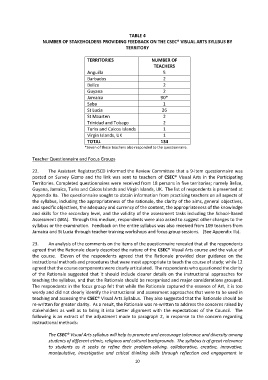Page 1382 - SUBSEC October 2017_Neat
P. 1382
TABLE 4
NUMBER OF STAKEHOLDERS PROVIDING FEEDBACK ON THE CSEC® VISUAL ARTS SYLLBUS BY
TERRITORY
TERRITORIES NUMBER OF
TEACHERS
Anguilla 5
Barbados 2
Belize 2
Guyana 2
Jamaica 90*
Saba 1
St Lucia 26
St Maarten 2
Trinidad and Tobago 2
Turks and Caicos Islands 1
Virgin Islands, UK 1
TOTAL 134
*Seven of these teachers also responded to the questionnaire.
Teacher Questionnaire and Focus Groups
22. The Assistant Registrar/SCD informed the Review Committee that a 9-item questionnaire was
posted on Survey Gizmo and the link was sent to teachers of CSEC® Visual Arts in the Participating
Territories. Completed questionnaires were received from 18 persons in five territories; namely Belize,
Guyana, Jamaica, Turks and Caicos Islands and Virgin Islands, UK. The list of respondents is presented at
Appendix IIa. The questionnaire sought to obtain information from practising teachers on all aspects of
the syllabus, including the appropriateness of the rationale, the clarity of the aims, general objectives,
and specific objectives, the adequacy and currency of the content, the appropriateness of the knowledge
and skills for the secondary level, and the validity of the assessment tasks including the School-Based
Assessment (SBA). Through this medium, respondents were also asked to suggest other changes to the
syllabus or the examination. Feedback on the entire syllabus was also received from 109 teachers from
Jamaica and St Lucia through teacher training workshops and focus group sessions. (See Appendix IIb).
23. An analysis of the comments on the items of the questionnaire revealed that all the respondents
agreed that the Rationale clearly described the nature of the CSEC® Visual Arts course and the value of
the course. Eleven of the respondents agreed that the Rationale provided clear guidance on the
instructional methods and procedures that were most appropriate to teach the course of study; while 12
agreed that the course components were clearly articulated. The respondents who questioned the clarity
of the Rationale suggested that it should include clearer details on the instructional approaches for
teaching the syllabus, and that the Rationale should be reorganised and major considerations grouped.
The respondents in the focus group felt that while the Rationale captured the essence of Art, it is too
wordy and did not clearly identify the instructional and assessment approaches that were to be used in
teaching and assessing the CSEC® Visual Arts Syllabus. They also suggested that the Rationale should be
re-written for greater clarity. As a result, the Rationale was re-written to address the concerns raised by
stakeholders as well as to bring it into better alignment with the expectations of the Council. The
following is an extract of the adjustment made to paragraph 2, in response to the concern regarding
instructional methods:
The CSEC® Visual Arts syllabus will help to promote and encourage tolerance and diversity among
students of different ethnic, religious and cultural backgrounds. The syllabus is of great relevance
to students as it seeks to refine their problem-solving, collaborative, creative, innovative,
manipulative, investigative and critical thinking skills through reflection and engagement in
10

